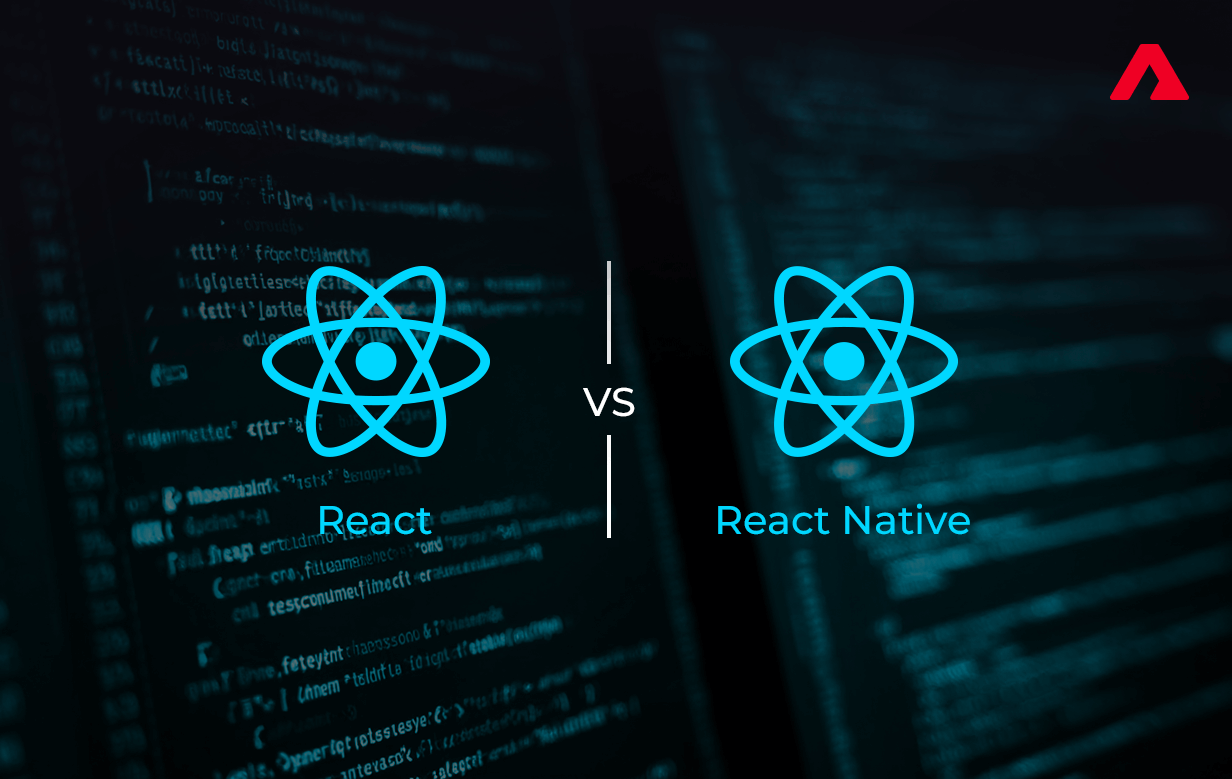Meta, previously known as Facebook, introduced two robust open-source JavaScript technologies: React and React Native. In recent years, these technologies have gained notable popularity for a reason. Today, businesses want both web and mobile apps as they serve as direct channels for marketing and promotion and help increase product visibility. Whether it is a web app or a mobile app, a well-chosen tech stack is key to its success. This is why a subtle difference between React and React Native makes a significant difference in application development.
This blog will help you explore the differences between these two technologies and assist you in deciding which one to choose.
An Overview of React
React, also known as ReactJS is a JavaScript library and highly esteemed within the development community. It is widely used for creating interactive and dynamic user interfaces (UIs) for web applications. Also, it enables developers to update and render components in the browser’s Document Object Model (DOM). React primarily focuses on the “view” layer of the application and lets other tools handle routing, state management, data fetching, etc. This gives developers flexibility in how they want to architect their apps.
Here’s a simple example of a React component that displays a counter:
import { useState } from "react";
const Counter = () => {
const [count, setCount] = useState(0);
return (
<div>
<h1>Counter: {count}</h1>
<button onClick={() => setCount(count + 1)}>Increase</button>
</div>
);
}
export default Counter;
An Overview of React Native
React Native is an open-source JavaScript framework that extends the capabilities of React to build native mobile applications. It allows developers to create high-performing, cross-platform apps (iOS and Android) using a single codebase. While it shares React’s declarative and component-based architecture, React Native differs in its implementation, performance characteristics, and use cases. Instead of rendering to the web DOM, it renders to native UI components, providing a native-like user experience.
Here’s an example of a simple React Native component:
import React, { useState } from 'react';
import { View, Text, Button, StyleSheet } from 'react-native';
const CounterApp = () => {
const [count, setCount] = useState(0);
const handleIncrease = () => setCount(prevCount => prevCount + 1);
return (
<View style={styles.container}>
<Text style={styles.counterText}>Counter: {count}</Text>
<Button title="Increase" onPress={handleIncrease} />
</View>
);
};
const styles = StyleSheet.create({
container: {
alignItems: 'center',
justifyContent: 'center',
flex: 1,
padding: 16,
backgroundColor: '#F5FCFF',
},
counterText: {
fontSize: 28,
marginBottom: 12,
fontWeight: '600',
},
});
export default CounterApp;
How React and React Native Work
Before we know how React and React Native work, we must know that both are fundamentally built on JavaScript. This means JavaScript is prominently used in core logic, component definitions, state management, and event handling. Initially, React was used as a tool for building web interfaces, and then React Native was launched to extend that functionality to mobile platforms. Whether it’s React or React Native, JavaScript is the primary language to create the UI logic for applications. JavaScript-based rendering allows developers to reuse code and speed up development on both web and mobile.
React uses virtual DOM –
When there is any change in the component, React first updates the Virtual DOM. Then, it uses a different algorithm to compare the updated DOM virtually with the previous one and calculates the required changes. This method makes React ideal for creating fast and dynamic web apps, as it enhances performance and prevents direct changes in the real DOM.
React Native connects JavaScript with Native components –
React Native leverages “bridge” or bridgeless architecture to communicate between JavaScript code and the underlying native mobile components and APIs. This is why apps built with React Native give a native-like experience while still allowing developers to write most of their code in JavaScript. This approach makes React Native a powerful and ideal technology for building responsive cross-platform applications.
Mentioned is an analogy to explain how React and React Native work:
Platform Targeting:
React is suitable for building web applications and is ideal for web development services.
On the other hand, React Native is specifically designed for mobile app development. It renders components into native UI elements that give users a native-like experience.
Rendering Mechanism:
React utilizes the Virtual DOM to update web interfaces with high efficiency.
React Native uses native APIs to render components to ensure performance similar to native apps.
Styling Approach:
React uses CSS and other standard web styling techniques.
React Native uses JavaScript-based stylesheets, which resemble CSS but are tailored specifically for mobile platforms.
Updates:
Both React and React Native have experienced significant updates in recent times.
React 19 is the latest stable version, and it improves everything that React 18 has introduced. One of the key highlights of this update is the smoother support for async that fastens the interactions in your apps. Additionally, this update also has features like built-in form handling and better server-side support. Overall, this update makes it easier to build modern, high-performing web applications and ensures a smoother user experience.
React Native has transformed due to its new architectural upgrade that seamlessly enables a performance boost. This lets developers create apps that look native on most platforms while optimizing runtime performance.
Practical Implications
Understanding the operational difference between React and React Native is the first step towards making an informed decision in development. React is suitable for web applications that require a dynamic UI. Its rendering capabilities handle UI updates efficiently. Besides, React Native is ideal for applications with cross-platform compatibility to achieve native-like functionality.
Navigation
React Router provides robust routing solutions and manages navigation for web applications built with React. Also, these libraries are helpful in managing browser history and URL state within the React application.
React Navigation or React Native Navigation usually handles navigation for React native applications. These libraries are designed to meet the unique needs of mobile applications, including stack, tab, and drawer navigators. Additionally, they contain mobile-specific features like gesture handling, responsiveness, and easy user interactions.
Code Sharing
React:
React components, logic, and state management are stored within the JavaScript ecosystem. It enables developers to reuse components across web projects and enhances efficiency in development.
React Native:
React Native has platform-specific adjustments and can share specific code between different mobile platforms. That means developers can write code for iOS and Android while reducing development time.
How to Choose Between React and React Native
The growing demand for React and React Native will always make it confusing to choose between them. However, understanding your project requirements, goals, and target platforms with available resources will help you make informed decisions. Both of these technologies are robust and serve different purposes, such as:
React is an ideal fit if you want to build high-performance web applications like a dashboard, single-page applications, or progressive web applications. It will facilitate the development of responsive and dynamic UIs while integrating with tools and libraries for routing, state management, and data handling.
And in contrast, if your goal is to build cross-platform applications with a single codebase, then React Native is a great fit. It will enable developers to create apps faster without compromising the performance quality.
Advantages of React vs React Native
React and React Native each offer distinct advantages based on their intended platforms.
Both technologies enable faster development and code reusability and have strong community support. Let’s explicitly understand their strengths and why they are ideal for web and mobile application development, respectively.
| React | React Native |
|---|---|
| With React, developers can build reusable UI components and save development time and maintenance overhead. | With React Native, developers can create a cross-platform app using a single codebase. |
| React uses a virtual DOM that speeds up rendering, enabling the building of highly interactive web applications. | React Native uses native components to enable app performance similar to native apps. |
| React has a huge ecosystem of libraries, tools, and resources. | Hot reloading allows developers to see the impact of code changes instantly without restarting the app. |
| Developers are backed by an active community for tutorials, plugins, and solutions, reducing learning curves. | React Native also has an expanding community providing resources, support, and third-party libraries for developers. |
| React supports server-side rendering that strengthens search engine visibility. | React Native is relatively easy for developers to learn and work with. |
| React is highly adaptable and integrates easily with other libraries and frameworks. | React Native bridges JavaScript with native APIs and enables developers to add features like GPS, cameras, and push notifications without a hassle. |
| React is popular for its flexibility and versatility; developers can seamlessly update projects without worrying about compatibility. | React Native’s unified codebase across iOS and Android reduces platform-specific bugs and simplifies debugging and optimization efforts during deployment. |
Disadvantages of React vs React Native
| React | React Native |
|---|---|
| React is dependent on additional tools for routing, state management, etc, which significantly increase setup complexity. | Integrating native modules in React Native can be complex and often requires writing platform-specific code. |
| Virtual DOM can still underperform in highly graphics-intensive applications. | Hybrid and cross-platform apps may perform more slowly compared to native apps due to heavy animations or computations. |
| SEO performance can be limited in single-page applications (SPAs) if server-side rendering isn’t properly configured. | Debugging can be complex sometimes while bridging native and JavaScript code. |
| React is not ideal for creating mobile apps | Larger app sizes and third-party dependencies can impact performance and stability. |
Conclusion
React and React Native are both dynamic technologies, but they serve different purposes. React provides unmatched flexibility and speed and is ideal for building a responsive, high-performing, dynamic web interface. In contrast, React Native is popular for building dynamic cross-platform apps that give a native-like experience. Understanding your product’s goals, timeline, and user expectations is the key to choosing the right tool.
At Atharva System, we don’t just write code for websites and applications; we help businesses make strategic technology decisions. Whether you’re planning a mobile-first product, a scalable web platform, or both, our team brings the technical expertise and business insight to move your idea forward with the right stack.
Need help making the right call between React and React Native?
Let’s talk about what works best for your product.
Connect with us today at contact@atharvasystem.com
Visit us at https://www.atharvasystem.com to learn more.




 Insurance
Insurance


























